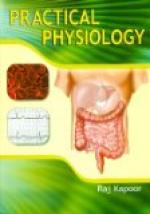The blood, having done its work and now laden with impurities, is picked up by minute veinlets, which unite again and again till they at last form one great trunk called the hepatic vein. This carries the impure blood from the liver, and finally empties it into one of the large veins of the body.
After the blood has been robbed of its bile-making materials, it is collected by the veinlets that surround the lobules, and finds its way with other venous blood into the hepatic vein. In brief, blood is brought to the liver and distributed through its substance by two distinct channels,—the portal vein and the hepatic artery, but it leaves the liver by one distinct channel,—the hepatic vein.
[Illustration: Fig. 59—Showing the Relations of the Duodenum and Other Intestinal Organs. (A portion of the stomach has been cut away.)]
150. Functions of the Liver. We have thus far studied the liver only as an organ of secretion, whose work is to elaborate bile for future use in the process of digestion. This is, however, only one of its functions, and perhaps not the most important. In fact, the functions of the liver are not single, but several. The bile is not wholly a digestive fluid, but it contains, also, materials which are separated from the blood to be cast out of the body before they work mischief. Thus, the liver ranks above all others as an organ of excretion, that is, it separates material of no further use to the body.
Of the various ingredients of the bile, only the bile salts are of use in the work of digestion, for they act upon the fats in the alimentary canal, and aid somehow in their emulsion and absorption. They appear to be themselves split up into other substances, and absorbed with the dissolved fats into the blood stream again.
The third function of the liver is very different from those already described. It is found that the liver of an animal well and regularly fed, when examined soon after death, contains a quantity of a carbohydrate substance not unlike starch. This substance, extracted in the form of a white powder, is really an animal starch. It is called glycogen, or liver sugar, and is easily converted into grape sugar.
The hepatic cells appear to manufacture this glycogen and to store it up from the food brought by the portal blood. It is also thought the glycogen thus deposited and stored up in the liver is little by little changed into sugar. Then, as it is wanted, the liver disposes of this stored-up material, by pouring it, in a state of solution, into the hepatic vein. It is thus steadily carried to the tissues, as their needs demand, to supply them with material to be transformed into heat and energy.
151. The Pancreas. The pancreas, or sweetbread, is much smaller than the liver. It is a tongue-like mass from six to eight inches long, weighing from three to four ounces, and is often compared in appearance to a dog’s tongue. It is somewhat the shape of a hammer with the handle running to a point.




